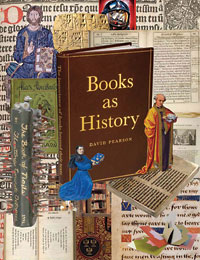Is the Book History?
A revised edition of David Pearson's exceptional book
By Rebecca Rego Barry Rebecca Rego Barry is the editor of this magazine.
Books as History
By David Pearson
The British Library & Oak Knoll Press
208 pages
paperbound
extensive color illustrations
$29.95
“What do books offer us, beyond words, and how do their physical formats and design characteristics contribute to their overall impact? Where do we draw the line between the book as a text and the book as an object, something which cannot be entirely replicated by transferring the content to another medium?”
David Pearson, Director of Libraries, Archives, and Guildhall Art Gallery at the City of London, presents this set of questions and then explores the various ways that physical books speak to those who will listen—through the way they are printed, illustrated, bound, annotated, altered, or defaced. It is a topic of obvious importance to historians, curators, librarians, and book collectors, but also one that is becoming ever more crucial to a wider audience of people concerned with the idea of ‘libraries without books,’ and physical books versus e-books. Pearson persuades us that it is time to separate books from texts, and let them go their merry ways.
Books are unique artifacts, objects, cultural products. In several chapters, Pearson cultivates the idea of variety, even in mass-produced books, and submits that small differences in printing (between editions or printings) or binding often have much to tell us about the culture that produced them. The chapter “Variety Through Ownership” will be of particular interest to collectors of association copies, for Pearson tracks how provenance adds another layer of meaning to a book through inscriptions, annotations, stamps, bookplates, marginalia, embellishments, and other copy-specific information.
This chapter, like all of the others, is gorgeously illustrated with full-color images of bindings, bookplates, pages of print, pages of manuscript, dust jackets, advertisements, and book art; reading the captions alone would impress the unconverted.
In chapter two, “Books Beyond Texts,” Pearson offers this intriguing exercise: he shows three versions of a Shakespearean sonnet—a 1609 printing, a twentieth-century edition, and a handwritten one—and then asks the reader to consider how the meaning of the text might change in each reading experience. He writes, “typography, layout, physical format and everything surrounding the words themselves all contribute to the framework within which meaning is constructed.”
What some might term fetishizing, book historians call valuing the artifactual nature of the book. The container does matter, and not simply because it is beautiful to behold, but because it is a text in and of itself. Pearson succeeds in providing a history of the book that is serious and thought provoking without being pedantic. In a perfect world, Books as History would be required reading for students of history, contemporary culture, literature, and library science.
First published in 2008, this edition has been revised to reflect the immense changes in the book industry that have occurred over the past few years. The new cover design is brilliant—the vivid, playful collage of medieval monks with manuscripts, intriguing book art, a young woman reading a Kindle. Does it suggest the chaotic nature of the book in 2011? Is it designed to appeal to a larger, non-academic audience? These are questions prompted by the physicality of this book, not the “text” itself, and that’s the point.








